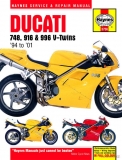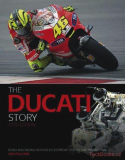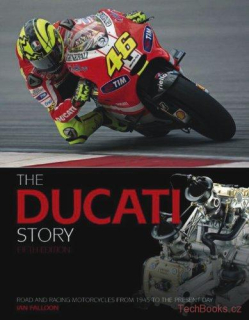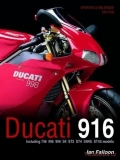Úvod »Automobily osobní a dodávky»UAZ » Ducati 916 & 996
Anotace
| Vazba: | Brožovaná | ||
| Počet stran: | 160 | ||
| Rozměry v mm: | 210 x 280 | ||
| Počet obrázků: | 200 | ||
| Rok vydání: | 2011 | ||
An aesthetic and performance revolution in its day, the In many ways, almost any bike from the supremely desirable Ducati 916-996 range can be described as a two-wheeled Ferrari – it has the pure Italian élan which is only found in machinery designed and built in that country, needs skilful handling to get the best performance out of it, is expensive to buy and maintain, and usually comes in red! However, before the first 916 arrived in November 1993 it's fair to say that the Ducati reputation was probably at its lowest ebb; the outdated bikes being produced at the end of the 1980s generally lacked performance and were unreliable. The renaissance of Ducati can undoubtedly be credited to the 916's stunning combination of power and style created by designer Massimo Tamburini. At the heart of the svelte scarlet 160mph machine was a throbbing, deep-throated, four-stroke V-twin that generated enough grunt to satisfy the most demanding rider, an engine which would eventually win SuperBike championships for a group of racers who would become world famous.
Rated at 109bhp at 10,000rpm, the 916cc, 8-valve, water-cooled, 90-degree V-twin came with fuel injection and desmodromic valves. The first 916 Strada had a single seat, alloy subframe, single-sided swingarm suspension mounted onto the frame and engine crankcase, and was available in red only. For 1995 the Strada was replaced by the 916 Biposto, which had a dual seat and a steel subframe, and the weight had increased to 204kg (the Strada weighed 198kg). Further improvements were announced for 1997, as was the availability of the colour yellow, but the most significant news was the takeover by an American organisation, the Texas Pacific Group. The new owners pledged to sort out the cash flow problems which had delayed deliveries and also to resolve other reliability issues. In the meantime, various homologation specials and limited-edition models were produced, culminating in the 916 SPS Foggy Replica brought out midway through the 1998 World SuperBike championship. Made to homologate a revised design of frame and airbox, only 200 of these machines (which had five-spoke wheels and racing stickers) were built and sold solely in the UK.
1998 also saw the arrival of the big-bore 996cc engine and the model named was changed to reflect this. Available in red or yellow, the 996 Biposto came with 112bhp on tap, a new alternator, uprated brakes and the option of single or dual seats. Again, there were special variants – the 996 SPS, 996 S and 996 R – before the classic 916 pedigree was ended by the Testastretta in 2001. Despite its faults, the enduring appeal of the Ducati 916-996 is rooted in its exclusivity and sensuality. This doesn't come cheap, and the Ducati doesn't suit everyone, but those who become entranced by it are more than willing to forgive the lack of comfort and practicality in exchange for the sheer enjoyment that comes from riding such a demanding bike as it was meant to be ridden. A comprehensive appreciation of this wonderful Italian motorcycle can be found in the articles reproduced in this book. A total of 160 fully illustrated pages.


























